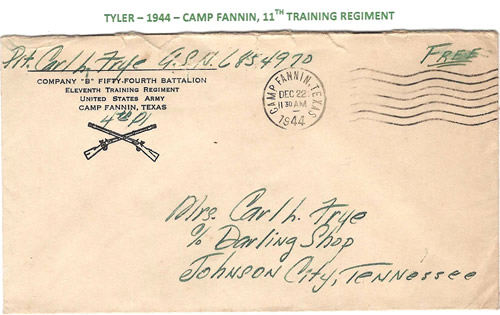|
Texas | WWII
CAMP FANNIN
U.S. Army Infantry
Replacement Training Center
and Prisoner-of-War Camp
32°26'N 95°11.5'W
Tyler,
Texas |
Camp Fannin
TX, Third Platoon Co. II, Oct. 3, 1945
Gladewater, Texas
Click on image to enlarge
Photo courtesy Carl Stroud |
CAMP FANNIN
Camp Fannin, an
infantry-replacement training center of World
War II, was located ten miles northeast of Tyler.
The reservation was a wooded, hilly site of more than 14,000 acres
named for James Walker Fannin, Jr. Construction was begun on December
1, 1942; Col. John A. Robenson assumed command on March 16, 1943;
and the camp headquarters, 361st Service Command Unit, was activated
on April 25, 1943. The replacement-training center was activated on
May 29, 1943, and the first trainees arrived in June. Formal dedication
of the camp was held on September 6, 1943. Colonel Robenson was succeeded
as commanding officer by Lt. Col. Charles H. Brammel on August 4,
1943. Maj. Sam H. Burchard commanded the prisoner-of-war camp located
at the station. Troop capacity at the height of war operations was
18,680, and the camp had hospital beds for 1,074. All except the cantonment
was declared surplus on January 19, 1946. At the end of World
War II in 1945, the camp was converted to a separation center
for the discharge of soldiers. Two years later, some of the buildings
were placed on the new campus of Tyler Junior College. The abandoned
base became the East Texas State Tuberculosis Sanatorium the following
year.
Anonymous,
“Camp Fannin,” Handbook of Texas Online, accessed February 07, 2023,
https://www.tshaonline.org/handbook/entries/camp-fannin. Published
by the Texas State Historical Association. |
|
One
of the happy yields of the fiftieth anniversary of World
War II has been the publication of reminiscences of the citizen
soldiers who interrupted lives to serve in the various branches
of the military service.
Two such pieces were prepared for the East Texas Historical Journal
that focus on Camp Fannin, an infantry replacement training center
located approximately ten miles northeast of Tyler.
The first article, "Camp Fannin": A Reminiscence," was written by
Laurence C. Walker, originally from Washington, D.C. Ironically,
after the war Walker earned a doctorate in Forestry and spent many
years as dean of the school of forestry at Stephen F. Austin State
University, located about 75 miles south of where he learned to
be a soldier. Walker served in the European Theatre.
The other article was prepared by Russell Rulau of Iola, Wisconsin,
and was prompted by Walker's earlier publication. Rulau's overseas
service was in the Pacific Theatre. After the war he became a writer
and dealer in the field of numismatics.
Walker and Rulau symbolize what happened at Camp Fannin from its
operation from May 29, 1943, until converted to a separation center,
then declared surplus in January 1946. They came from different
parts of the United States and served in different theatres, yet
each contributed to what FDR called "the inevitable victory."
Camp Fannin, which occupied 14,000 acres of woodland hills, was
named in honor of James Walker Fannin, a soldier in the Texas Revolution.
Its first commander was Colonel John A. Robenson, who was succeeded
by Lieutenant Colonel Charles H. Brammel in August 1943. Troop capacity
was 18,680 and the camp hospital could accommodate 1,074 patients.
A prisoner of war camp commanded by Major Sam H. Burchard also occupied
the site.
Walker, Rulau, and others remember experiences with the Southern
heat, ticks, chiggers, and other discomforts, but also dances and
visits to Kilgore--where
alcohol was available--and Tyler,
where it was not.
Like so many in what Tom Brokow has convinced us was our "Greatest
Generation," the men who learned to soldier at Camp Fannin and other
training facilities throughout the land did not falter when it was
their turn to serve.
Some of Camp Fannin's facilities were moved to the campus of Tyler
Junior College for more use, and part of the base became the East
Texas State Tuberculosis Sanitarium. Some of the men who trained
there remain forever in cemeteries in foreign lands, and many others,
including Walker and Rulau, lived long and projective lives in the
land they helped keep free.
All
Things Historical September
10, 2000
Published by permission.
(Archie P. McDonald is Director of the East Texas Historical Association
and author or editor of more than 20 books on Texas)
|
 |
Camp Fannin,
Texas Forum
I see you have
a new article on Camp Fannin. I wanted to make sure any interested
individuals know that the Texas General Land Office did a cultural
resources review of Camp Fannin in 2010 in anticipation of our building
a Texas Veterans Home on part of old Camp Fannin. Information held
by the GLO on Camp Fannin can be found listed here: https://txarchives.org/txglo/finding_aids/00023.xml
Best,
Mark Lambert, MLIS, MA
Deputy Director for Archives and Records
Texas General Land Office |
|
|
